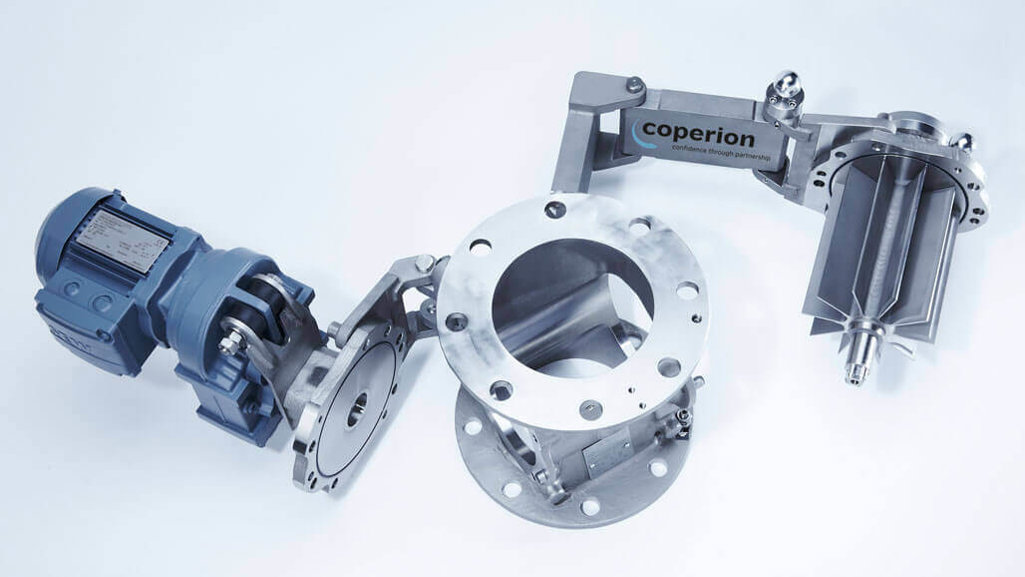Jochen Sprung, Head of Sales and Business Development, gave this interview to Dairy Foods Magazine.
How important are dairy powder valves in helping dairy processors produce high-quality products and having the most efficient operations?
注册订阅科倍隆新闻通讯,查看我们最新动态
Questions & Answers on challenges and technology solutions for dairy powder producers.
Jochen Sprung, Head of Sales and Business Development, gave this interview to Dairy Foods Magazine.
How important are dairy powder valves in helping dairy processors produce high-quality products and having the most efficient operations?

High efficiency sanitary valves are important components in a variety of dairy processing applications.
Jochen Sprung , Head of Sales and Business Development at Coperion
Spray drying of dairy powders such as milk powder, lactose, and infant or nutrition formulas require hygienic rotary valves and diverter valves such as the Coperion model ZRD hygienic rotary valve and model WYK diverter valve. These valves are typically located at the discharge of the spray dryers and throughout the subsequent material handling and conveying process. The valves play an important role and are considered as key components to discharge the finished product out of the drying process and for transport to storing and packaging.
What powder valve elements are most important for dairy processors to consider when purchasing the equipment for their operations?
It is essential for the maintenance and preservation of these hygienic operations that dairy processors consider the following key elements when specifying powder valves:
During the spray drying process, moisture and warm temperatures are conducive to bacterial growth. Therefore wet cleaning is normally applied. The wet cleaning process can require extensive resources. Time and costs can be saved if the washing process can be automated (Clean In Place or CIP). As stated above, Coperion offers special components that can be cleaned in the process without need for dismantling. This also reduces the risk of external contamination in the process. Coperion CIP rotary valves are designed such that the rotor stays in the housing and discharges the washing liquids by rotating. Retention-free design including special CIP gaskets at the inlet and outlet as well at the sideplates assure that no product or liquid remains anywhere. Contamination with curdled milk suspensions and subsequent CIP tests at authorized institutes have proven that the components are clean and contamination free.
Conversely, the Coperion stainless steel WYK-CIP diverter valve has also been specifically designed for CIP cleaning in powder conveying lines. The conical rotor is switched between conveying tubes via an actuator while the diverter is operated in conveying mode. During cleaning, the rotor is extracted slightly by a second actuator which allows the cleaning liquid to reach all areas of the inside while the diverter is still closed to the outside. The WYK diverter valve does not need to be opened during or after CIP and yet is thoroughly clean afterwards, which saves time and costs.
How have dairy powder valves been evolving in recent years to provide better functionality for processors?
The designs of dairy powder rotary and diverter valves have evolved significantly. These design changes include the shift from aluminum parts to polished stainless steel, often with a minimum of Ra 0.8 micron surface finishes. In addition, improved overall sanitary design, FDA approved gaskets and elastomers, adherence to EHEDG and USDA guidelines/regulations and fully CIP-able designs are now available.
What are the biggest challenges that dairy processors face in leveraging the optimal powder valves for their operations?
Challenges often faced by dairy processors include valve accessibility as well as the challenge of possible contaminants going undetected from the valve into the product.
For example, diverter valves are often installed in conveying piping in difficult to access areas. This makes opening the valve for frequent wet cleaning difficult if not impossible. Therefore, the availability of a fully CIP-able valve is an optional solution, as these valves can be proven to be 100% free of bacterial contamination after cleaning, thus preventing any microbial growth. As stated above, the Coperion WYK-CIP is just such a valve.
Rotary valves are also often in locations which are difficult to clean and maintain. Ideally a rotary valve would not be opened because each opening is a risk of contamination from the outside environment. Coperion ZRD valves are also available in a fully CIP execution. Additionally, in cases where full CIP is not possible, the ZRD-CIP valves are designed for complete accessibility from both the rotor and the drive sides, an added plus for maintenance as well as cleaning.
Finally, dairy processors can be faced with the possibility of metal wear or contaminants in their product/process. Unintended contact between the rotary valve rotor and housing can occur because of a number of issues including:
As a new innovation, the Coperion RotorCheck 5.0 is now available as a contact monitoring system for Coperion rotary valves. It is the ideal technology to register, evaluate and report unwanted contact between the rotor and housing in order to prevent metallic abrasion, and thus potential contamination of the product being conveyed or transferred. Dairy applications for a variety of powders, especially those with a high number of cleaning cycles, as well as applications which include frequently changing products and recipes, can particularly benefit from this instrumentation. The newly introduced physical separation of measured value logging and evaluation electronics has advantages in terms of operation and maintenance, while the redeveloped control system provides advanced options for event diagnosis and communication to host systems. This design option can contribute to longer uninterrupted running times, thus optimizing operational efficiency.
What steps can they take to meet those challenges?
As shown in the design options outlined above, it is imperative that dairy processors select the right valve execution and design features which will improve operational efficiency, minimize downtime for cleaning/maintenance and product and process safety.
How are dairy powder valves likely to evolve over the next few years?
As outlined above, valves will continue to evolve to include more CIP-able operations with lowered cleaning times and avoidance of manual cleaning. In addition, valves will evolve to be suitable for longer production cycles.

Head of Sales and Business Development, Coperion
